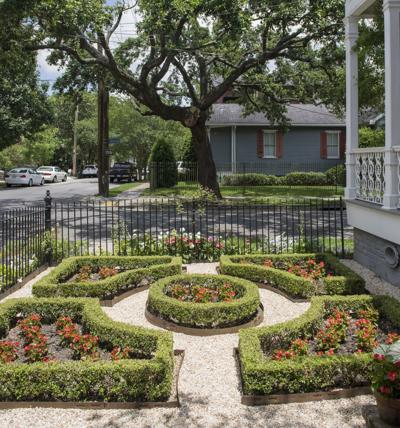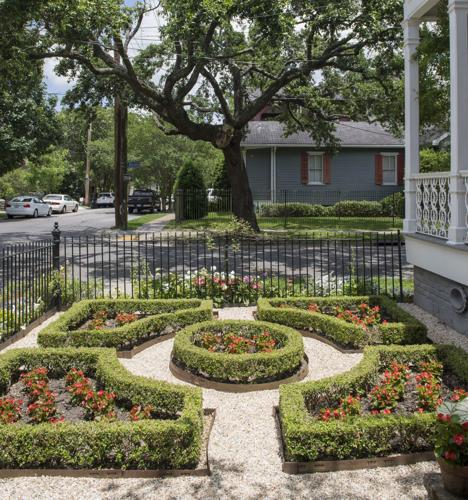If you are considering planting a hedge, now is a great time to get it done. This allows the shrubs to take advantage of the less stressful conditions during the cool season to get established in the landscape before the heat of summer arrives. Newly planted hardy shrubs will not be bothered by winter freezes.
The primary reason many hedges are planted is to create privacy for outdoor living areas. They are less expensive than constructing a wall and create a more natural look.
Hedges are also important for screening out unattractive views, such as an unattractive nearby building. A hedge can be a sound barrier and help to moderate noise originating outside your property. They also can help provide enclosure in the landscape, creating more intimate spaces and dividing the landscape into rooms.
Tips for planting
When creating a hedge, shrubs are generally planted in single rows; a zigzag planting will increase the thickness of the hedge and is also done occasionally. Generally, only one type of shrub is used to create a hedge, but mixing several types of compatible shrubs can also be effective, especially when creating a large screen or sound barrier.

Many hedges are planted is to create privacy for outdoor living areas. They are less expensive than constructing a wall and create a more natural look.
Properly spacing the shrubs is important and varies with the plant material selected. Spacing is, however, generally closer than we might typically plant the shrubs for other landscaping purposes. This is because closer spacing, within reason, helps provide quicker results. A spacing of 3 to 5 feet is typical, but small hedges, like a clipped boxwood or dwarf yaupon hedge 2 feet tall, might be spaced less than 2 feet. And exceptionally wide-growing shrubs, such as Russian olives that may grow to be 10 feet across, can be spaced farther apart.
Planting the shrubs in well-prepared soil is important to make sure they grow as fast as possible. First, get rid of any unwanted vegetation and till the soil in a strip about 2 feet wide (depending on the situation) and the length of the area where they will be planted. Next, spread a 2- to 4-inch layer of organic matter (compost, processed or aged manure, peat moss) over the area, and thoroughly incorporate that into the upper eight inches of soil.
Make sure that you do not plant the shrubs too deeply. The top of the root ball should be level with or slightly above the soil of the bed. Finally, mulch the planting and water it thoroughly to settle the soil.
Continuing care
In April, fertilize the shrubs with a general-purpose granular fertilizer following package directions. You will need to water the shrubs during summer dry spells.
An easy and efficient way to do this is to run a soaker hose at the base of the shrubs and cover it with mulch. When you need to water, simply attach a garden hose to the soaker hose and turn it on. Allow it to irrigate until the water has penetrated about six inches or more into the soil. I usually leave my soaker hose on for about an hour. Fertilize again in June or July.
Is time on your side?
Good bed preparation, fertilizing the shrubs twice a year and keeping them mulched and well-watered during the summer are the best ways to encourage the shrubs to grow as fast as they can. Still, you will need to be patient.
If you need immediate privacy, building a fence or some other structure is the way to go. Hedges take time to grow. Even fast-growing plants will generally take three to five years before they begin to do the intended job.
Keep trimming
Training your hedge is important. Most hedges are pruned at least occasionally as they grow to encourage them to be thick and full. For a more formal look, hedges can be sheared regularly. The most important aspect to pruning is to make sure the top does not grow out wider than the base.
Most shrubs want to produce a wide top and narrower base, especially when they are simply sheared across the top occasionally. If this happens, the wide top of the hedge will shade out the lower parts, causing them to lose their foliage and creating a hedge that is leggy and can be seen through. When training the hedge, always keep this in mind and make sure the top is somewhat narrower than the bottom.
Choosing the plants
When selecting the type of plant to use you must look at your desires and taste, the purpose of the hedge, the desired height and the growing conditions. It is harder to grow full, thick hedges in a shady area and you have fewer choices, although hollies, ligustrum, sasanquas, camellias, Chinese mahonia, nandina and cleyera will all tolerate some shade.
Here are some hedge choices, listed by size:
For a 3- to 5-foot hedge: Consider dwarf yaupon holly, Chinese mahonia, dwarf sasanqua, dwarf oleander, azaleas, Indian hawthorn, nandina and Rotunda holly.
For hedges 6 to 10 feet: Ligustrum, cleyera, camellia, sasanqua, oleander, dwarf Burford holly, gardenia, pittosporum, and Indian azaleas are possible choices.
For taller hedges and screens: Look at Savannah holly, Dahoon holly, Teddy Bear magnolia, banana shrub, sweet olive, Japanese viburnum, sweet viburnum, Japanese yew, ligustrum, cherry laurel, loropetalum, Russian olive or elaeagnus, pineapple guava, Needlepoint holly, Nellie R. Stevens holly, wax myrtle and yaupon holly.
Again, carefully consider the characteristics you want the shrubs to have. Besides size, being evergreen and growing fast, consider shrubs that also produce flowers, fragrance or attractive or edible fruit.
Garden columnist Dan Gill answers readers' questions each week. To send a question, email Gill at dgill@agcenter.lsu.edu.


